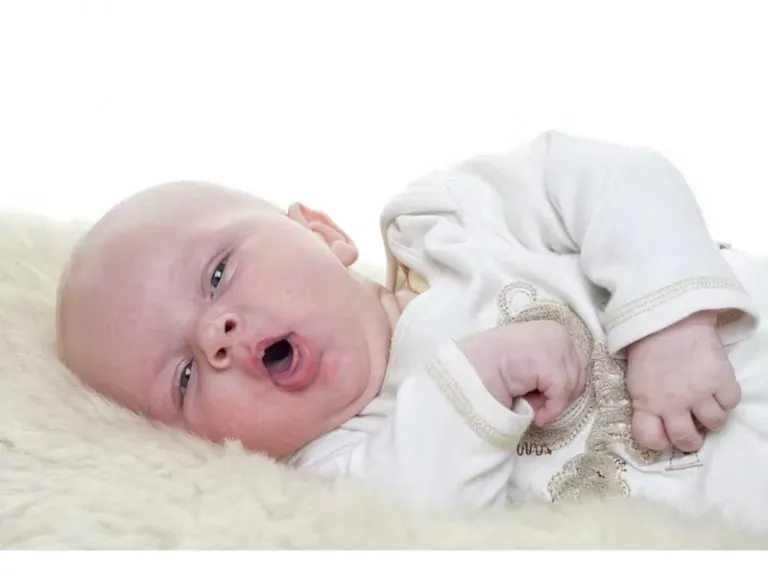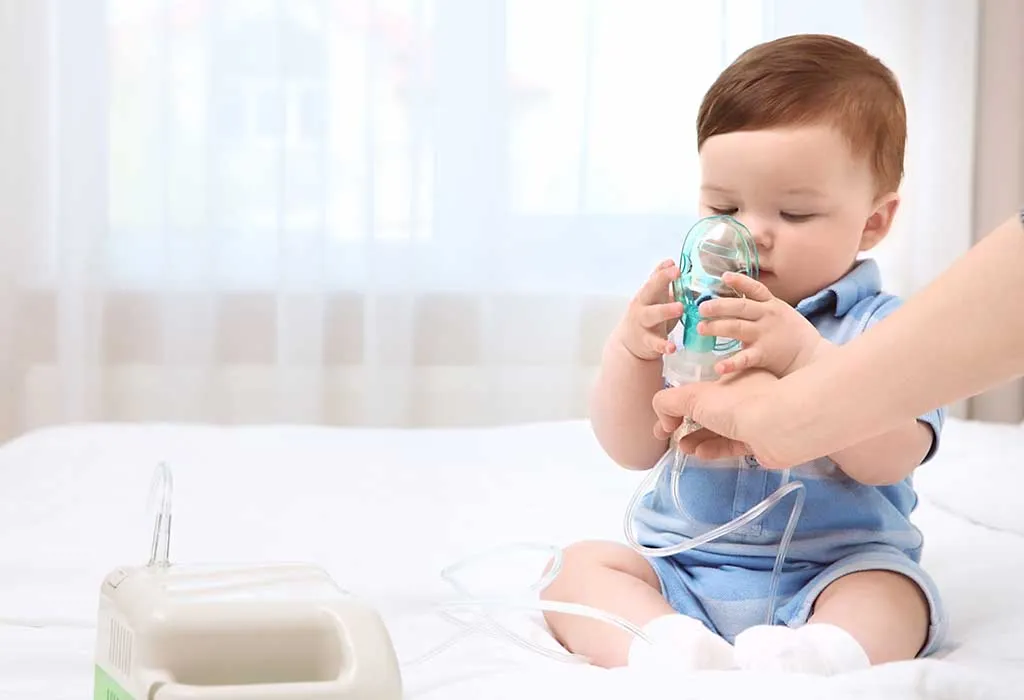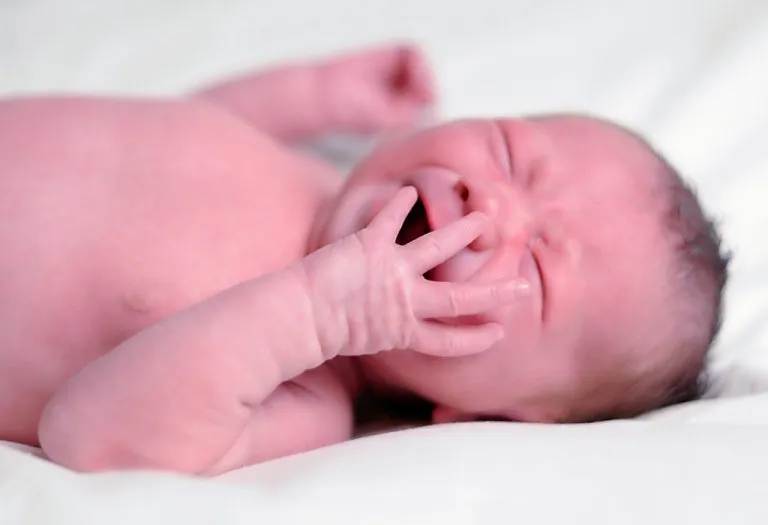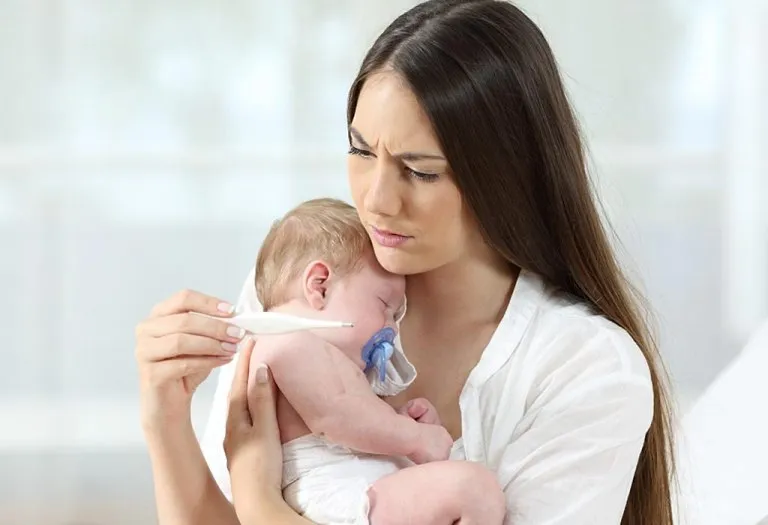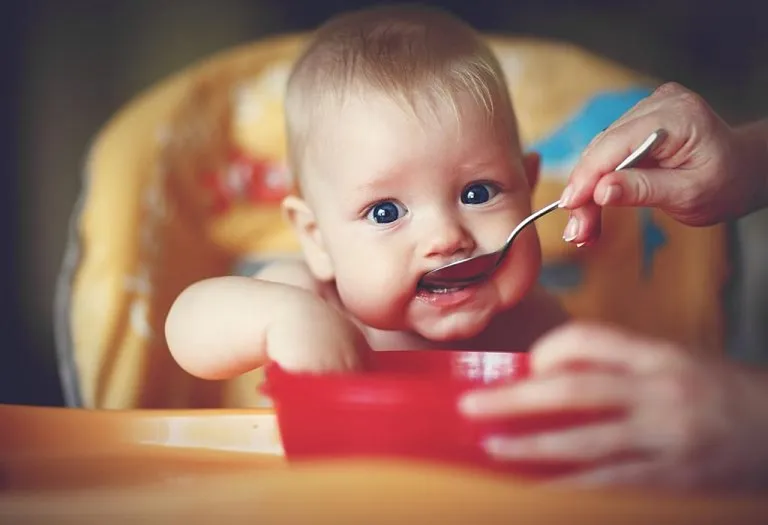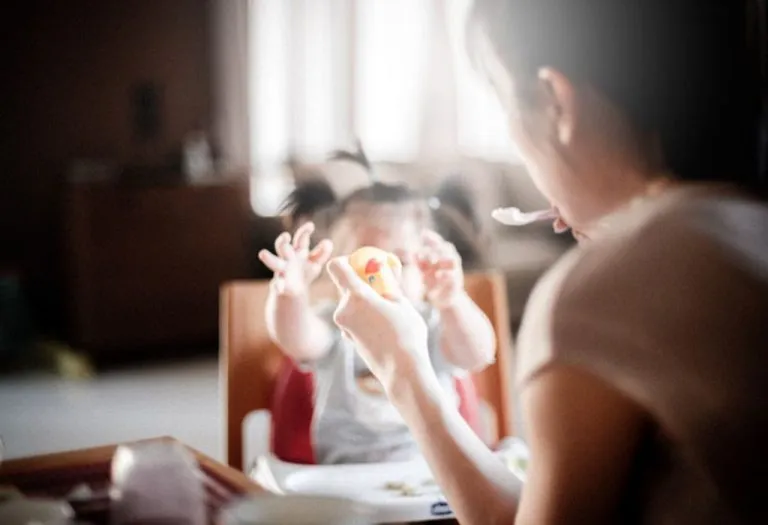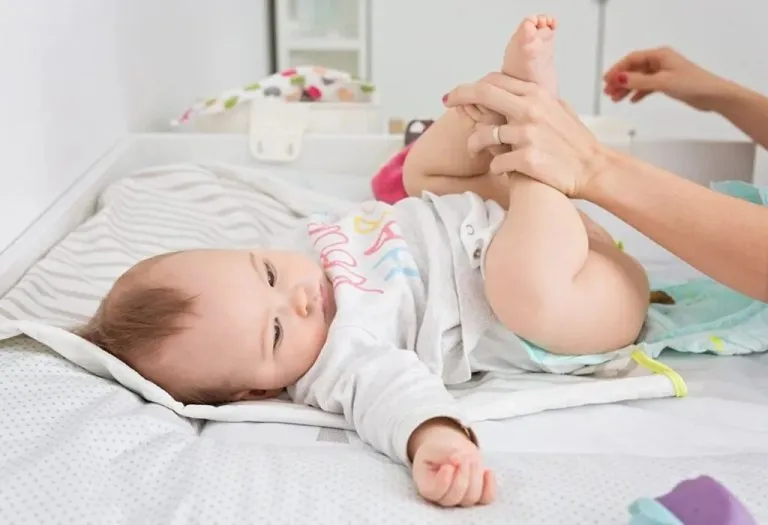Baby Wheezing – Causes, Symptoms and Remedies
Wheezing manifests itself in the form of a high-pitched noise like whistling when a baby breathes. A baby wheezing when breathing sounds more like a wind blowing through a tunnel. It could also sound like a toy squeaking when squeezed. This whistling sound while breathing is common in babies and children. A wheezing sound in babies indicates that the airways are narrowed which forces the air through a tiny opening that causes the sound. The frequency and intensity of wheezing depend on the underlying causes. About 30% of infants experience wheezing at least once. Asthma, infections, gastroesophageal reflux disease (GERD), and allergies are some common causes of wheezing.
What Is Wheezing in Infants?
Tiny breaths accompanied by a whistling sound is what characterizes wheezing in babies (1). Small airways, among other things, cause them to make a wheezing sound in infants when they breathe. A few are common whilst some can be a cause of concern.
Breathing sounds in infants can vary. Babies generally take slow, deep breaths when they are asleep as compared to when they are awake. Wheezing is different from heavy breathing. A few grunts, snores or sighs are not the same as wheezing. Generally, wheezing occurs while exhaling. It occurs when the lower airway passages in the lungs are blocked or become narrow. Mucus in the baby’s nose could cause a noise when the baby breathes. Though many things could cause newborn babies wheezing issues, it is hard to ascertain it is wheezing without a stethoscope.
A consistent sound that sounds like whistling or breaths accompanied by a rattling sound needs to be investigated further.
Is It Normal for Infants to Sound Wheezy?
It’s not uncommon for infants to sound wheezy from time to time, often due to respiratory infections or conditions like bronchiolitis. Wheezing can occur when the airways are inflamed or filled with mucus, which can be triggered by common colds, allergies, or even early signs of asthma. While occasional wheezing may be benign, persistent or severe wheezing, especially if accompanied by difficulty breathing, fever, or lethargy, should be evaluated by a healthcare provider.
The Different Types of Baby Wheezing
Understanding the different types of wheezing in babies is crucial for determining the underlying cause and appropriate treatment. Wheezing can be a sign of various conditions, each with its own characteristics and triggers. Here are some common types of baby wheezing and what they might indicate:
1. Wheezing Due to Allergies or Asthma
When wheezing occurs in response to environmental pollutants like dust or pet hair, or if it follows a seasonal pattern, it is often linked to allergies or asthma. In such cases, the wheezing may be accompanied by other allergy symptoms, such as a runny nose or itchy eyes. This type of wheezing is usually triggered by exposure to specific allergens and may improve with the removal of the allergen or with the use of allergy medications.
2. Wheezing Caused by Respiratory Infections
Sudden onset of wheezing, especially if accompanied by a cough, fever, or congestion, is often due to a respiratory infection like bronchiolitis or a common cold. These infections can cause inflammation and mucus buildup in the airways, leading to wheezing. This type of newborn wheezing typically resolves as the infection is treated and the inflammation decreases.
3. Wheezing Due to Foreign Body Obstruction
If wheezing starts abruptly and is associated with choking or difficulty breathing, it could be due to a foreign object lodged in the airway. This type of wheezing requires immediate medical attention to remove the obstruction and alleviate the airway blockage.
4. Persistent Wheezing from Birth
Persistent wheezing that has been present since birth may indicate a congenital issue with the baby’s airway anatomy. Conditions such as cystic fibrosis or primary ciliary dyskinesia could be the cause. Persistent or severe wheezing in such cases requires thorough medical evaluation and diagnostic testing to determine the exact cause and appropriate management.
Causes of Baby Wheezing
A common symptom that indicates an abnormality in the breathing of the baby or issues in the respiratory tract, wheezing could be caused by infections or autoimmune disorders. Below are a few causes that could cause wheezing:
1. Viral or Bacterial Infections
Bacterial infections can cause inflammation and accumulation of mucous which narrows the airways. This can be aggravated to such an extent that the baby is unable to breathe in air. Viruses and bacteria that cause cold, tonsillitis, bronchitis, upper respiratory infection, and pneumonia could lead to wheezing issues (2).
2. Allergies
Babies can be allergic to substances in the air. Airways which lead to the lungs, can react to allergen and lead to inflammation and secretion of additional mucus. This leads to shortness of breath and wheezing. Dust, dust mites, pet fur, dander, cockroaches, pollen, and mold are common allergens that babies can develop wheezing.
3. Diseases Genetically Inherited
Genetic diseases like asthma could cause wheezing in children as they inherit those genes. Asthma can also be triggered due to exposure to an allergen and could cause recurrent wheezing until the age of five (3). Cystic fibrosis is another inherited disease that causes wheezing. It generates mucous which blocks the airways.
4. GERD
Gastroesophageal reflux disease is a chronic acid reflux problem where the stomach and stomach acid contents tend to flow through the esophagus into the throat. This causes irritation when it comes in touch with the airways. The irritation and blockage of the windpipe because of the stomach contents leads to wheezing (4).
5. Sleep Apnea
Where the obstruction in the airway, sleep apnea can occur. A common condition arises owing to infection in tonsils and adenoids. Tissues expand, resulting in infection and press hard against the airway, which leads to wheezing while breathing.
6. Choking
Choking on food like grapes, nuts, and raisins or tiny toys could obstruct the airways. This obstruction leads to narrowing of the airway that can cause wheezing while breathing.
7. Cavities, Tumors, Respiratory Anomalies
Tumors in the throat, chest cavity, dysfunction in the vocal cord, upper respiratory tract anomalies, problems with the circulatory system, and congenital heart problems could be uncommon causes of wheezing.
8. Bronchopulmonary Dysplasia
This condition develops in premature babies who need ventilators and oxygen support as their lungs are underdeveloped at birth, often leading to wheezing in babies.
Signs of Wheezing in Infants
The most obvious sign of wheezing is the whistling or rattling sound when the baby inhales and exhales. But if the sound is not very audible and you suspect that your baby’s breathing is not normal, then the most common signs and symptoms of baby wheezing are:
- The baby will show faster belly movements than usual. One can even see the expansion and contraction of the chest.
- If you see the neck muscles tighten while breathing, it means the baby is distressed while breathing
- Nostrils flare up repeatedly and remain wide open. When the baby exhales, there is a whistling sound.
- Skin becomes pale, flushed, and blue. Sometimes it can even become red. This could be because of a lack of oxygen in the blood.
- Cold, cough, and fever
- Rapid heartbeat
- Sweating
- Lack of appetite
- Shivering
- Congestion in chest, runny nose, constant sneezing
- Itchy and watery eyes
- Throat pain and choking
When to Worry About a Baby’s Wheezing
Wheezing is common in babies when they are afflicted with cold or common respiratory infections. It generally disappears when the infection goes away. However, it can be a cause of concern in the following situations:
1. Wheezing When Eating
A baby wheezing while eating could indicate choking or food obstructing the airway, especially if they have never had a wheezing problem.
2. Wheezing When Alone
Babies must not be left alone, especially when they begin to crawl or walk. Babies can easily access small objects and are not aware of risks. Foreign objects can obstruct airways and cause choking or wheezing sounds when they breathe.
3. Wheezing When Sleeping or Eating
If wheezing does not let the baby sleep or eat properly, then it is a cause of worry.
4. Wheezing After a Missed Dose of Medication
Infants on medication for medical conditions need to be administered medication on time. If they miss a dose, then it could cause a surface of symptoms. Babies with asthma need an inhaler at all times for emergencies.
5. Discomfort all of a Sudden
If the baby suddenly develops wheezing and seems to have severe discomfort when breathing, you must consult a doctor immediately.
6. High Fever or Pneumonia
If your child has a temperature of over 104 degrees Fahrenheit and is having breathing difficulties, then there is cause to worry.
Diagnosis of Baby Wheezing
Diagnosing the cause of wheezing in infants involves a comprehensive approach to identify the underlying issue and determine the most effective treatment. Proper diagnosis is essential for addressing the symptoms and managing any associated conditions. Here’s an overview of the diagnostic process for baby wheezing:
1. Physical Examination
The doctor will start with a thorough physical examination to listen to the baby’s breathing and check for signs of respiratory distress (5). This helps in identifying any immediate issues that may be contributing to the wheezing, such as infections or anatomical abnormalities.
2. Medical History Review
A detailed review of the baby’s medical history, including any recent illnesses, exposure to allergens, or family history of respiratory conditions, is crucial. This information can provide valuable insights into potential triggers or predisposing factors for the wheezing.
3. Laboratory Tests
Blood and mucus samples may be collected and sent to a laboratory to check for signs of infection or inflammation. These tests can help identify if a bacterial or viral infection is causing the wheezing and guide appropriate treatment.
4. Breathing Tests
If the initial examination and history suggest possible asthma or chronic respiratory issues, breathing tests may be conducted. While more common in older children, these tests can sometimes provide insights into lung function and the presence of airway obstruction.
5. Imaging Studies
In some cases, imaging studies such as a chest X-ray or ultrasound may be ordered to rule out structural abnormalities, foreign body obstruction, or more serious conditions like pneumonia or bronchitis. These images help in visualizing the airways and lungs (6).
6. Specialist Consultation
If wheezing is persistent or the cause remains unclear, referral to a pulmonary or respiratory specialist may be necessary. Specialists can perform more detailed evaluations and provide targeted treatments, especially for conditions like asthma or cystic fibrosis.
How to Treat Wheezing in Babies
What to do for baby wheezing? How does one treat the condition in babies? Solutions to treat the wheezing problem for baby boys and girls include:
1. Antibiotics
These work well with bacterial infections. If one strictly follows the course, it could help rid the root cause that caused the wheezing.
2. Prescribed Medication and Procedures for Treatment
Babies with conditions like asthma or cystic fibrosis will need a well-chalked-out treatment to control their wheezing condition. These conditions cannot be cured entirely but managed with proper medications and treatments. Wheezing could be controlled with the help of a nebulizer.
3. Surgery for Complex Conditions
Other severe causes for wheezing like infected adenoids and tonsils or sleep apnea would need corrective surgery. Surgery is not required if the condition can be treated with medications. Rare causes like congenital heart conditions could warrant surgery and some care after.
4. Humidifiers
Humidifiers increase the moisture content in the air and help to reduce the risk of dryness. Dryness could cause difficulty in breathing thereby resulting in wheezing. Cool mist humidifiers could help infants with respiratory illnesses or infections.
5. Clear the Nose
With the help of saline drops and a bulb syringe, you could suck the mucus if the baby has a cold. It helps to clear the nostril, clearing the airways and helps the baby to breathe. Seek the advice of a pediatrician for the best saline drops for your child.
6. Hydration and Rest
Keeping your baby well-hydrated and ensuring they get plenty of rest is essential when they are wheezing. Hydration helps thin out mucus in the airways, making it easier for your baby to breathe, while rest gives their body time to heal. Offer fluids frequently to keep them hydrated, especially if they are battling a cold or respiratory infection.
Home Remedies for Baby Wheezing
A few home remedies that will help with wheezing are:
1. Mustard Oil Massage
Mustard oil soothes breathing, improves blood circulation, and clears the respiratory tract.
What You Need
- A few tsp of mustard oil
- Camphor
How to Do
- Heat mustard oil and add camphor
- Once camphor dissolves, massage the baby’s chest for 10-15 minutes.
How Many Times
- 3 times a day
2. Raw Onions
Onions have a high content of sulphuric acid that fights infection, clears blocked airways and treats wheezing.
What You Need
- 1 raw onion
How to Do
- Cut onion and grind. Add it to baby food and feed your baby.
- Alternatively, you could also place a raw onion near the bed.
How Many Times
- Include in one meal of the day
3. Steam Bath
This is one of the best home remedies for wheezing in infants. It has the same effect as a humidifier. It melts the mucus and clears the respiratory tract.
What You Need
- Hot water
- Eucalyptus or essential oil
How to Do
- Fill the bathtub with hot water.
- Add a few drops of eucalyptus/essential oil.
How Many Times
- Once a day
Preventive Measures
While you cannot completely prevent wheezing, there are some preventive measures that you can take:
- Protect baby from pathogens by keeping surroundings clean.
- Administer medication on time
- Take care to keep any object or food item that could risk choking away from children
- Any early signs that seem worrying, especially rapid breathing and restlessness, must not be ignored
When Should You Call the Doctor?
Take your baby to a doctor if your baby is wheezing. Any diagnosis will help. Some symptoms need to be addressed quickly. Seek medical attention in the following circumstances:
- Flushed skin
- Rattling in chest
- High fever
- Dehydration
- Severe allergic reaction
FAQs
1. Can teething cause wheezing in babies?
Although teething itself does not directly cause wheezing, the increased saliva production during teething may lead to mild congestion, which can sometimes be confused with wheezing. In rare cases, babies may develop a slight cough or respiratory sounds during teething, but if true wheezing is present, it’s likely due to another underlying cause such as an infection or allergies.
2. Can weather changes worsen wheezing in babies?
Yes, sudden changes in weather, particularly cold or dry air, can exacerbate wheezing in babies with respiratory sensitivities. Cold air can tighten the airways and make breathing more difficult for some infants, especially those with underlying respiratory conditions like asthma or bronchiolitis.
3. Can vaccinations cause wheezing in babies?
While vaccinations are essential for protecting babies from serious illnesses, in rare cases, certain vaccines may cause mild respiratory reactions, including wheezing, as part of an allergic response. For instance, babies with egg allergies may react to vaccines made with egg proteins. However, such cases are rare, and the benefits of vaccination far outweigh the risks.
4. Can baby wheezing be a sign of heart problems?
Yes, in rare instances, wheezing can be associated with congenital heart conditions. Babies born with heart defects may have difficulty breathing or experience wheezing due to poor blood circulation, leading to fluid buildup in the lungs. If wheezing is accompanied by other symptoms like poor feeding, rapid breathing, or bluish skin, it may indicate a heart issue that requires immediate medical evaluation.
Wheezing in babies is a condition that needs to be addressed as it could be a minor or significantly harmful condition. If you are not sure of your baby’s breathing pattern, then make sure to seek an appointment with the doctor to rule out any possibilities.
References/Resources:
1. El-Gamal. Y, El-Sayed. S; Wheezing in infancy (World Allergy Organization Journal); National Library of Medicine; https://www.ncbi.nlm.nih.gov/pmc/articles/PMC3651148/; May 2011
2. Bronchiolitis-RSV; Seattle Children’s Hospital; https://www.seattlechildrens.org/conditions/a-z/bronchiolitis-rsv/
3. Weiss. L; The Diagnosis of Wheezing in Children; American Family Physician; https://www.aafp.org/pubs/afp/issues/2008/0415/p1109.html; April 2008
4. Gastroesophageal Reflux in Children; Stanford Medicine; https://www.stanfordchildrens.org/en/topic/default?id=gastroesophageal-reflux-in-children-90-P02364
5. Sarkar. M, Madabhavi. I, Niranjan. N, Dogra. M; Auscultation of the respiratory system (Annals of Thoracic Medicine); National Library of Medicine; https://www.ncbi.nlm.nih.gov/pmc/articles/PMC4518345/
6. Patel. P, Mirabile. V, Sharma. S; Wheezing; National Library of Medicine; https://www.ncbi.nlm.nih.gov/books/NBK482454/
7. McLaughlin. J, Khan. F, Schmitt. H, Agosti. Y, Jodar. L, et al.; Respiratory Syncytial Virus–Associated Hospitalization Rates among US Infants: A Systematic Review and Meta-Analysis (The Journal of Infectious Diseases); Oxford Academic; https://academic.oup.com/jid/article/225/6/1100/6042579; December 2020
Also Read:
Flu in Infants
Baby Gasping for Air
Baby Sleeps With Mouth Open
How to Check Your Baby’s Breathing
Was This Article Helpful?
Parenting is a huge responsibility, for you as a caregiver, but also for us as a parenting content platform. We understand that and take our responsibility of creating credible content seriously. FirstCry Parenting articles are written and published only after extensive research using factually sound references to deliver quality content that is accurate, validated by experts, and completely reliable. To understand how we go about creating content that is credible, read our editorial policy here.





